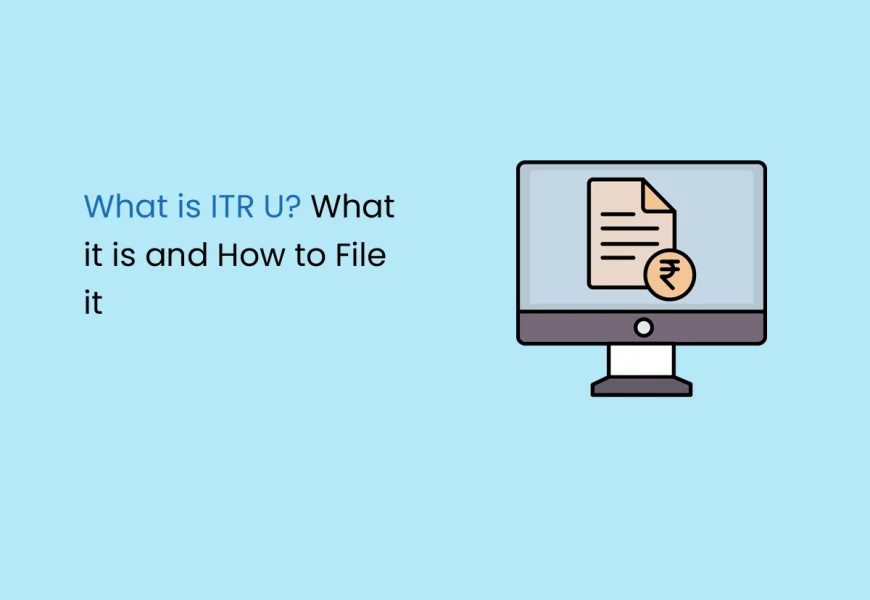It is essential for everyone who owes taxes to file an income tax return (ITR) to comply with the law and be transparent about their finances. The Income Tax Department of India has created a variety of forms to make the tax filing process easier for taxpayers, including the ITR-U, also known as the Updated Return. This form allows individuals to correct any errors or omissions that may have been made in their original return. It can be filed within two years from the end of the relevant assessment year. The government introduced Updated Returns in the Union Budget 2022.
This blog will explain ITR U, when it’s required, and how to file under Section 139(8A) of the Income Tax Act.
What is ITR U?
The ITR-U form, also known as the Updated Income Tax Return form, is a document that allows taxpayers to correct errors or omissions in their Income Tax Returns (ITRs) within two years from the end of the relevant assessment year. This form benefits those who have either not filed their ITR or made inaccurate entries while filing it.
It is important to note that the two years are calculated from the year-end when the original ITR was filed. This means taxpayers have sufficient time to review and update their ITRs in case they missed out on any details or made any errors while filing their returns.
Latest Update: You cannot file belated or revised ITRs after December 31st, 2023. However, you may use the ITR-U form from January 1st, 2024, to correct minor errors or omissions in your original ITR. ITR-U does not allow you to reduce income, claim refunds, or increase losses.
Eligibility to File ITR U under Section 139(8A)
If a person has made an error or omitted specific income details in any of the following tax returns, they are eligible to file an updated return:
- Original return of income
- Belated return
- Revised return
An ITR U can be filed in the following cases:
- The taxpayer missed the return filing deadline and the belated return deadline
- Income is not declared correctly
- The taxpayer chose the wrong head of income
- The tax was paid at the wrong rate
- The taxpayer wants to reduce the carried forward loss
- The taxpayer seeks to lessen the unabsorbed depreciation
- The taxpayer seeks to reduce the tax credit under Section 115JB/115JC
Taxpayers can file only one updated return for each assessment year (AY).
Who is Not Eligible to File ITR U under Section 139(8A)?
An ITR U cannot be filed in the following cases:
- An updated return has already been filed.
- When filing a nil return or loss return.
- When claiming or enhancing the refund amount.
- When the updated return results are lower, a search proceeding under section 132 is initiated against you.
- When a survey is conducted under section 133A.
- When books, documents, or assets have been seized or called for by the Income Tax authorities under section 132A.
- If assessment, reassessment, revision, or re-calculation is pending or completed.
- If there is no additional tax outgo.
Time Limit to File ITR U
The deadline for filing ITR U is 24 months from the end of the relevant assessment year. Updates can be made for the Return of Financial Year 2022-2023 (Assessment Year 2023-2024) until March 31, 2026.
For Example:
| Financial and Assessment Year | Last Date to File ITR U |
|---|---|
| FY 2020-21 (AY 2021-22) | March 31 2024 |
| FY 2021-22 (AS 2022-23) | March 31 2025 |
| FY 2022-23 (AY 2023-24) | March 31 2026 |
Penalty for Filing ITR U
Late filing of tax returns is always associated with penalties. If a return is filed within one year from the end of the relevant assessment year, an additional 25% of tax and interest due on the income not reported would be charged. If the return is filed after one year and within two years of the relevant assessment year, the penalty increases to 50% of additional tax and interest due.
For Example:
| Income Earned | Filing | Penalty Applicable |
|---|---|---|
| AY 2022-23 | April 1 2023 – March 31 2024 (12 months from the end of the relevant AY) | 25% of tax + interest (if applicable) + Late filing Fees |
| AY 2022-23 | April 1 2024 – March 31 2025 (24 months from the end of the relevant AY) | 50% of tax + interest (if applicable) + Late filing Fees |
How to File Form ITR U
As per income tax rules, you must furnish an updated return (ITR U) and an updated version of the applicable ITR form (ITR 1-7). The form has two parts – Part A & B. To fill-up the form, follow the instructions below:
Part A: General information
The following details must be given to update ITR U:
- Permanent Account Number (PAN)
- Name
- Aadhaar Card Number
- Assessment Year
- Select ‘Yes’ if filed previously for the assessment year.
- If ‘Yes’, check the ITR acknowledgement to determine if it was filed under section 139(1) or others.
- Next, enter the form, acknowledgement, or receipt numbers and the date of filing the original return (DD/MM/YYYY). The ITR acknowledgement contains all these details.
- Check the eligibility conditions and select the appropriate option.
- Select the ITR form number.
- Select the reasons for updating the ITR U (multiple selections are allowed).
- If 12 months have elapsed from the end of the year the return was filed, select the ’12-24 months option’. Otherwise, choose the ‘up to 12 months option’.
- If the updated return reduces carried forward loss or unabsorbed depreciation, mention the assessment year affected and any prior revised returns.
Part B: Calculation of Updated Income and Tax Payable (ITR U)
- Identify and mention the specific head of income under which the additional income is reported in the updated return. This could include income from salary, house property, business or profession, capital gains, or other sources.
- Provide the total income per the last valid return, but only if a return has been filed previously.
- Calculate the total income per Part B-TI (Total Income).
- Determine the amount payable or refundable based on the updated return. Consider any amount payable or refund claimed in the last valid return.
- Account for any fee applicable for default in furnishing the return of income under section 234F.
- Include the regular assessment tax, if applicable, in the calculation.
- Calculate the aggregate liability on the additional income reported in the updated return.
- Determine the additional income-tax liability based on the prescribed rates on the updated income.
- Calculate the net amount payable or refundable, considering all the factors mentioned above.
- Report any tax paid under section 140B in the return.
- Determine the tax due by subtracting the tax paid under section 140B from the net amount payable or refundable.
- Provide details of tax payments made under section 140B and payments of Advance Tax/Self-Assessment Tax/Regular Assessment Tax not claimed in the earlier return. Certain credits or reliefs may not be allowed again under section 140B(2), so ensure compliance with relevant regulations.
How to Calculate the Tax Payable for ITR U
The total income tax liability while filing ITR U would be as follows:
Total Income Tax Liability = Tax Payable + Interest +Late-filing fees + Additional Tax
Net Tax Liability = Total Income Tax Liability – TDS/TCS/Advance Tax/Tax Relief
| S. No. | Particulars | Match figure from | Amount (Rs.) |
|---|---|---|---|
| A | Tax payable on additional income per modified ITR | Modified ITR
(submitted along with ITR U) |
XXXX |
| B | Interest levied, if any, on additional income u/s 234A/234B/234C | Modified ITR
(submitted along with ITR U) |
XXXX |
| C | Late fee, if any, under Section 234F | Modified ITR
(submitted along with ITR U) |
XXXX |
| D | Taxes paid or relief TDS/TCS/Advance Tax/regular assessment tax/Relief | XXXX | |
| E | The total refund issued (including interest)/claimed per the original return. | Original return filed | XXXX |
| F | Aggregate tax liability on additional income | A+B+C+E-D | XXXX |
| G | Additional tax
25% or 50% on (F-C) |
XXXX | |
| H | Net Amount Payable | F+G | XXXX |
Verification of ITR U
The ITR U can be verified by the following:
- An Electronic Verification Code (EVC) is given for tax audit cases.
- Digital Signature Certificate (DSC) in non-tax audit cases.
Frequently Asked Questions about ITR U
Who is eligible for ITR form U?
Taxpayers can file an updated return u/s 139 (8A) for any errors or omissions in their earlier income tax return.
What is the ITR U section?
ITR U is used to revise tax return filings under Section 139(8A) of the Income Tax Act and differs from the forms used for filing the original tax return.
What is the ITR form for?
An Income Tax Return (ITR) is a form that taxpayers use to report information about their income earned and tax liability to the income tax department. The department has notified seven different forms to date, namely ITR-1, ITR-2, ITR-3, ITR-4, ITR-5, ITR-6, and ITR-7.
Is there any penalty for ITR U?
No penalty is imposed for filing ITR U. However, an additional tax will be levied under section 140B. The tax amount will be 25% or 50% of the tax & interest due, based on the filing duration from the end of the relevant assessment year.
Can nil return be filed in ITR U?
ITR U cannot be filed for Nil returns.
What are the benefits of filing Form ITR U?
Filling out ITR-U can avoid scrutiny, best judgment, and income-escaping assessments under 143(3), 144, and 147. It also prevents survey, seizure and search proceedings.
Can a refund be claimed in ITR U?
ITR U cannot be used to claim refunds, increased refund amounts, nil returns, or loss returns.
Can I file ITR U if I missed filing my ITR before the original due date?
You can file ITR U after the deadline but must pay a late filing fee and additional tax liability.














